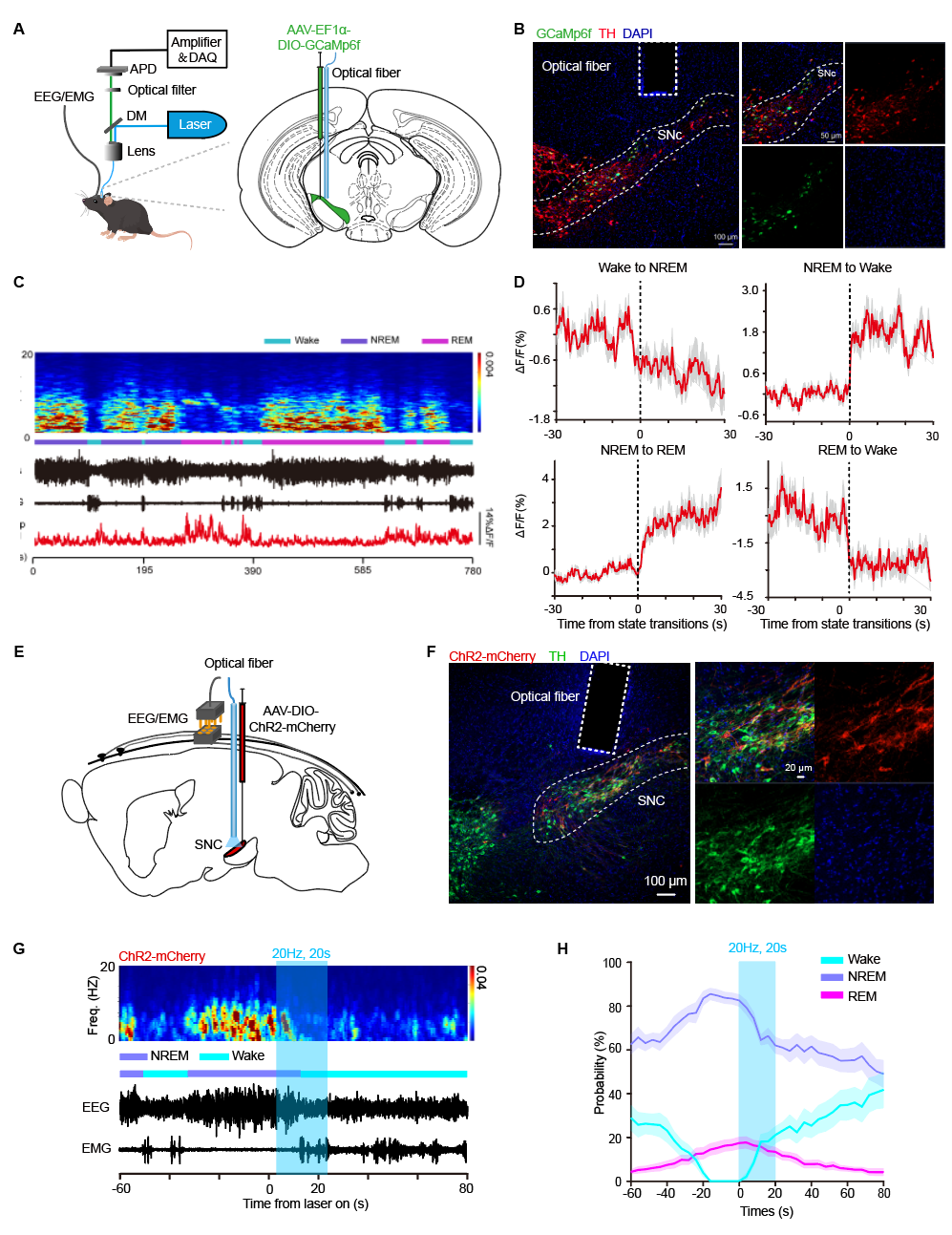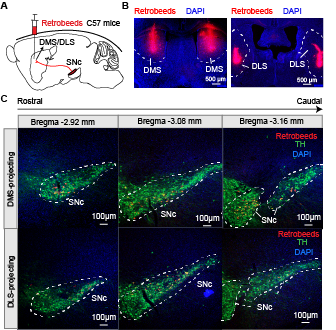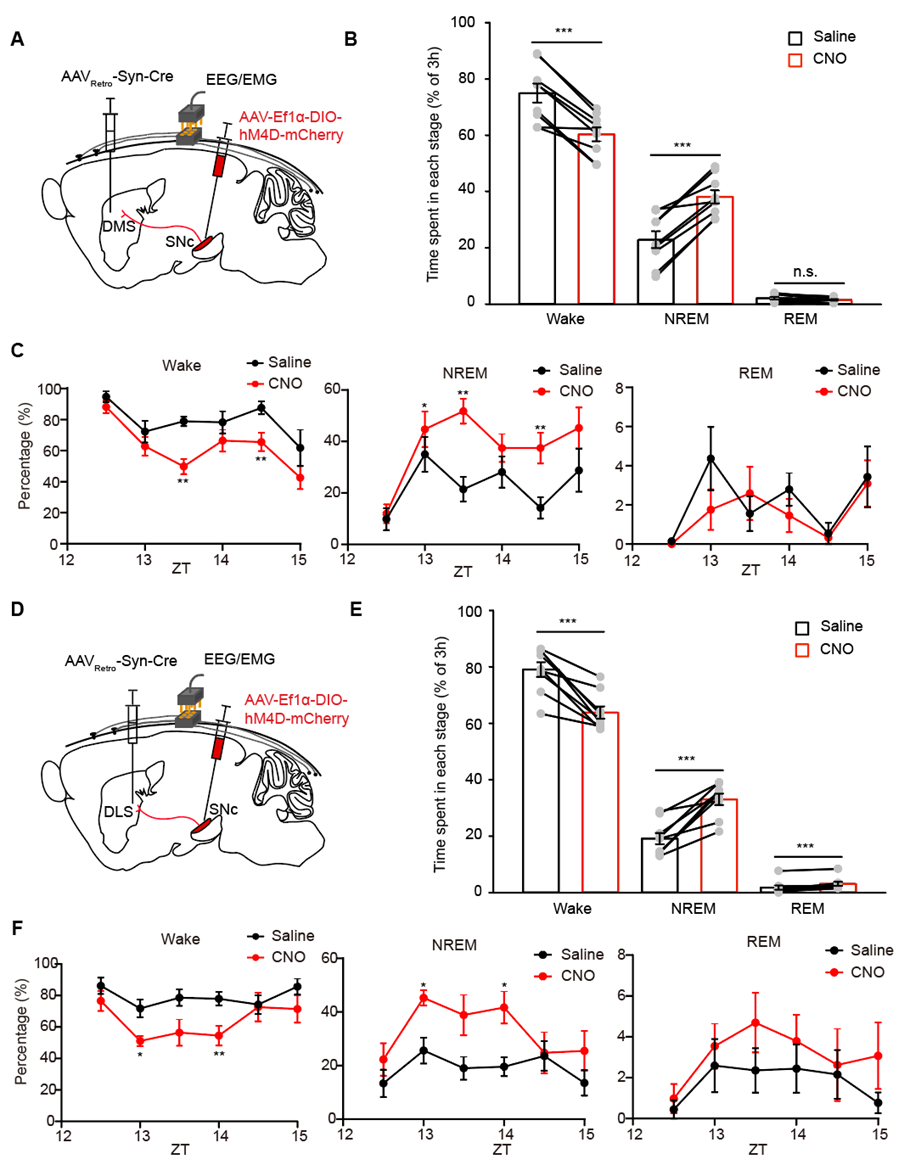Category: Parkinson's Disease: Non-Motor Symptoms
Objective: This study systematically investigates the involvement of dopaminergic (DA) neurons in substantia nigra pars compacta (SNc) in wakefulness-sleep regulation and explores the underlying circuit mechanisms, aiming to provide new insights into the pathogenesis of EDS in PD.
Background: Excessive daytime sleepiness (EDS) is a prevalent sleep disorder in Parkinson’s disease (PD), affecting approximately one third of patients. Despite its high prevalence, the etiology and pathophysiological mechanisms of EDS in PD remain obscure. SNc, a core locus of PD, has been implicated in the regulation of wakefulness and sleep. However, its precise role remains controversial.
Method: In vivo fiber photometry and electroencephalogram-electromyogram recordings were employed to examine the activity profiles of SNc DA neurons throughout sleep/wakefulness cycles. The role of SNc DA neurons in wakefulness-sleep regulation was studied by a combination of chemogenetic and optogenetic methods. Neural circuit tracing and manipulation techniques were utilized to explore the circuit mechanisms mediating the wakefulness regulatory function of SNc DA neurons.
Results: The population Ca2+ activity of SNc DA neurons was higher during wakefulness and rapid eye movement (REM) sleep than during non-REM sleep. Chemogenetic inhibition of SNc DA neurons significantly decreased wakefulness and increased sleep. Optogenetic activation of SNc DA neurons induced rapid wakefulness from sleep, while optogenetic inhibition reduced the probability of wakefulness. Retrograde tracing confirmed that dorsal medial striatum (DMS)-projecting neurons were localized to the medial SNc, whereas dorsal lateral striatum (DLS)-projecting neurons were in the lateral SNc. Two parallel nigrostriatal dopaminergic subpopulations were both active during wakefulness and REM sleep. Chemogenetic inhibition of the SNc-DMS or SNc-DLS resulted in a significant decrease in wakefulness.
Conclusion: SNc DA neurons were found to be sufficient for wakefulness, and the wakefulness-promoting function was mediated by both SNc-DMS and SNc-DLS. Lesions of SNc DA neurons and their downstream circuits, resulting from primary neurodegeneration, might underlie the development of EDS in PD.(Submitted to the IAPRD meeting on January 28th)
SNc DA neurons were sufficient for wakefulness
SNc DA neurons innervated DMS and DLS
Both SNc-DMS and SNc-DLS promoted wakefulness
References: Stefani A, Hogl B. Sleep in Parkinson’s disease [J]. Neuropsychopharmacology, 2020, 45(1): 121-128.
Tholfsen. Development of excessive daytime sleepiness in early Parkinson disease [J]. Neurology, 2015, 85(2), 162–168.
Yang S R, Hu Z Z, Luo Y J, et al. The rostromedial tegmental nucleus is essential for non-rapid eye movement sleep [J]. PLoS Biol, 2018, 16(4): e2002909.
Oishi Y, Suzuki Y, Takahashi K, et al. Activation of ventral tegmental area dopamine neurons produces wakefulness through dopamine D(2)-like receptors in mice [J]. Brain Struct Funct, 2017, 222(6): 2907-2915.
Qiu M H, Yao Q L, Vetrivelan R, et al. Nigrostriatal Dopamine Acting on Globus Pallidus Regulates Sleep [J]. Cereb Cortex, 2016, 26(4): 1430-1439.
To cite this abstract in AMA style:
HS. Liu, JW. Li, ZA. Hu, RC. Ren, XN. Xiong. Two parallel nigrostriatal subcircuits mediate the arousal effect of dopaminergic neurons in substantia nigra pars compacta [abstract]. Mov Disord. 2024; 39 (suppl 1). https://www.mdsabstracts.org/abstract/two-parallel-nigrostriatal-subcircuits-mediate-the-arousal-effect-of-dopaminergic-neurons-in-substantia-nigra-pars-compacta/. Accessed November 17, 2025.« Back to 2024 International Congress
MDS Abstracts - https://www.mdsabstracts.org/abstract/two-parallel-nigrostriatal-subcircuits-mediate-the-arousal-effect-of-dopaminergic-neurons-in-substantia-nigra-pars-compacta/



